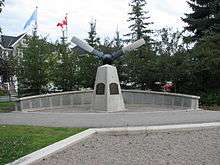Buffalo 461
|
A de Havilland Canada CC-115 in 2004 (30 years earlier, Buffalo 461 was painted white and its markings were not the same). | |
| Incident summary | |
|---|---|
| Date | 9 August 1974 |
| Summary | Shot down by missiles |
| Site | Ad Dimas, Syria |
| Passengers | 4 |
| Crew | 5 |
| Fatalities | 9 |
| Injuries (non-fatal) | 0 |
| Survivors | 0 |
| Aircraft type | de Havilland Canada DHC-5 Buffalo |
| Operator | Canadian Forces |
| Registration | 115461 |
| Flight origin | Beirut International Airport, Lebanon |
| Destination | Damascus, Syria |
Buffalo 461 was a Canadian military de Havilland Canada DHC-5 Buffalo assigned to the second United Nations Emergency Force force in Syria in support of United Nations Security Council Resolution 340. Assigned to a peacekeeping force, Buffalo 461 was shot down by three Syrian missiles[1] on August 9, 1974 killing all nine passengers and crew.[2]
The loss of Buffalo 461 remains both the largest single-incident loss of life in the history of Canadian peacekeeping operations[3] and was the most recent Canadian Forces aircraft shot down while in service until a Chinook helicopter was downed on operations in Kandahar, Afghanistan in August 2010.[4]
UN Flight 51
The second United Nations Emergency Force was authorized by the United Nations Security Council to supervise the ceasefire between Egypt and Israel following the end of the October War. Besides preventing additional flare-ups of fighting, the peacekeeping force was also tasked with assisting the Red Cross with humanitarian efforts in the region. Canada was a leader in these peacekeeping efforts and was providing logistics, signals and air and service units. Their three Buffalo aircraft were flying six-day-a-week schedules.[3]
UN Flight 51 was Buffalo 461's last flight designation, for a routine scheduled supply trip from Ismailia, Egypt to Damascus, Syria. Five crew members and four military passengers were on board when the aircraft took off from Beirut International Airport after a stopover.[2] The First Officer, Captain Keith Mirau, received clearance to enter Syrian airspace from the Damascas air traffic control centre at 0945 GMT. Shortly after crossing from Lebanon into Syria the plane was hit by a surface-to-air missile launched from a Syrian airfield. Moments later two more missiles struck and destroyed the plane, scattering wreckage across a field near the Syrian town of Ad Dimas. All nine on board were killed.
Aircraft
The aircraft, the 16th Buffalo built, first flown in 1968, was a twin-engined de Havilland Canada DHC-5 Buffalo (CC-115 - Canadian military designation) utility transport with Canadian military serial number 115461.[2]
Aftermath and legacy

The Canadian Department of National Defence launched a board of Inquiry to investigate the loss of Buffalo 461. The board was led by LCol J.A. McCann who was unable to determine if the missile attack was accidental or done intentionally to put pressure on the United Nations to curtail Israeli flights over Syrian airspace.[1]
The Canadian Warplane Heritage Museum has undertaken a project to rebuild an ex-Sudanese Air Force DHC-5D to represent Buffalo 461 as a tribute to those lost on Buffalo 461 and all Canadian peacekeepers.[5] August 9 has been established as Peacekeepers' Day by the Canadian government.[6] A fragment of the original aircraft is on display at the Canadian War Museum as a memorial to the lost crew members and passengers, who have become known as the Buffalo Nine, and [6] a memorial has also been erected at Buffalo Park in Calgary, Alberta.
See also
References
- 1 2 home.cogeco.ca, The last mission of Buffalo 461 , retrieved 27 June 2009
- 1 2 3 Incident description for de Havilland Canada CC-115 Buffalo 115461 at the Aviation Safety Network. Retrieved on 2009-06-27.
- 1 2 buffalo461.ca, Buffalo 461 - Last Flight, retrieved 27 June 2009
- ↑ Canada. "Canadian helicopter goes down near Kandahar". The Globe and Mail. Retrieved 2012-06-24.
- ↑ buffalo461.ca, CC-115 Buffalo Restoration, retrieved 27 June 2009
- 1 2 forces.gc.ca, "Day honours Canadians lost on peace support ops Archived June 9, 2011, at the Wayback Machine.", The Maple Leaf, 22 October 2008, p. 10, retrieved 27 June 2009
External links
- Canadian Landmine Foundation
- Chief of Defence Staff Announcement
- The Blue Beret - Canadian Armed Forces Veterans Newsletter